FRIDAY, OCTOBER 9
■ Last-quarter Moon (exact at 8:40 p.m. EDT). The Moon rises around 11 or midnight tonight local time. Once it does, look for Pollux a few degrees to its left and Castor above Pollux. Way high above them at that time is Capella. Far to their right, Orion is on its way up.
By dawn Saturday morning the 10th, the Moon stands high in the southeast — with the Gemini twin stars now glimmering to its upper left and brighter Procyon farther to its lower right, as shown below.
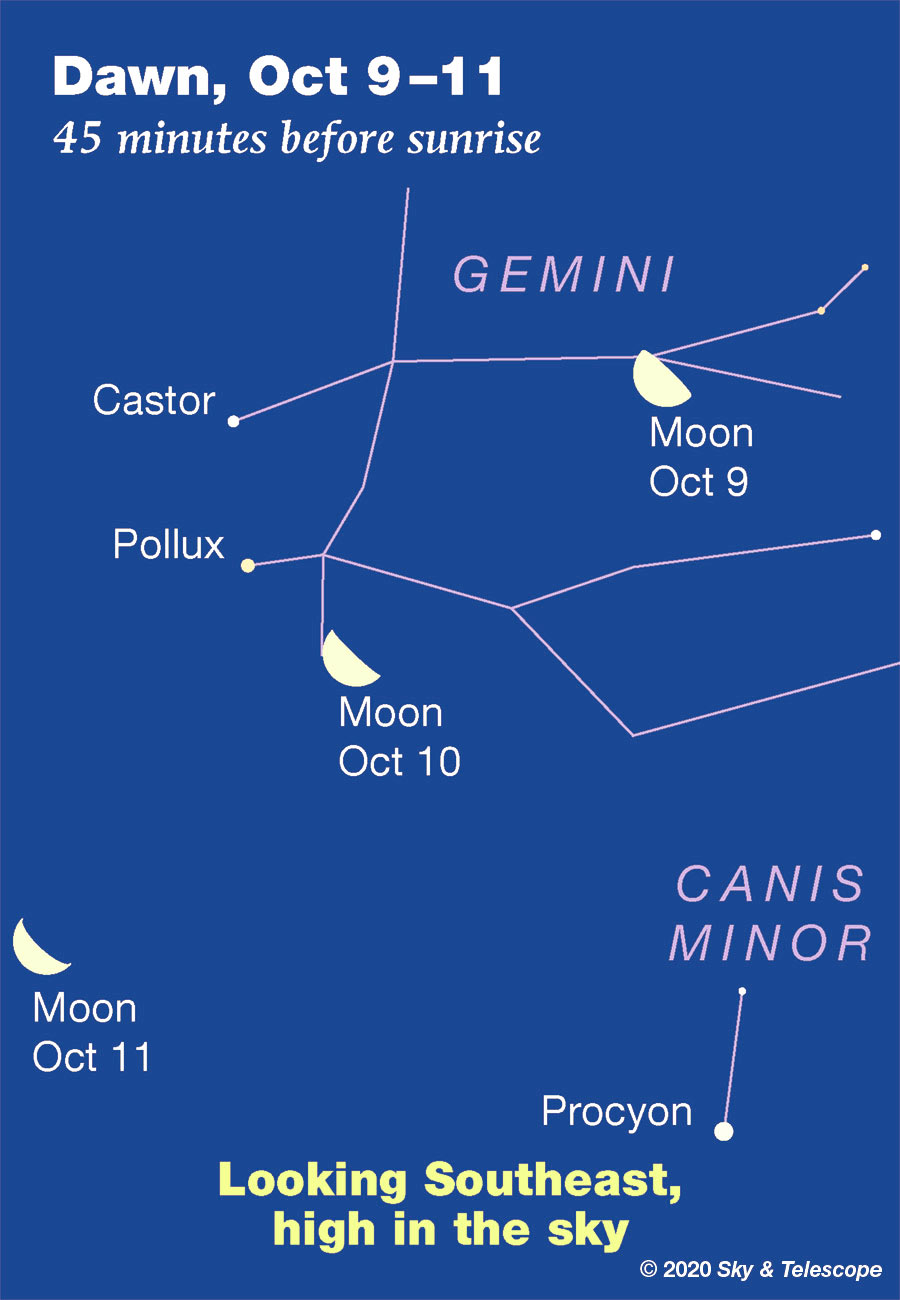
■ Jupiter's moon Io reappears out of eclipse from Jupiter's shadow around 8:27 p.m. EDT. In a telescope, watch it slowly glimmer into view a little east of the planet.
Right around that time, Jupiter's Great Red Spot should be transiting Jupiter's central meridian.
SATURDAY, OCTOBER 10
■ The Great Square of Pegasus balances on its corner high in the east at nightfall. For your location, when it is exactly balanced? That is, when is the Square's top corner exactly above its bottom corner? This will be sometime soon after the end of twilight, depending on your latitude. Try lining up the stars with the vertical edge of a building as a measuring tool. How accurately can you time this event?
SUNDAY, OCTOBER 11
■ Arcturus shines low in the west these evenings as twilight fades out. Capella, equally bright, is lower in the north-northeast (depending on your latitude; the farther north you are the higher it will be.) They're both magnitude 0.
Around the end of twilight, Arcturus and Capella shine at the same height. When exactly will this happen? That depends on both your latitude and longitude.
When it does, turn around and look low in the south-southeast. There will be 1st-magnitude Fomalhaut at the same height too — if you're at latitude 43° north (Boston, Buffalo, Milwaukee, Boise, Eugene). Seen from south of that latitude, Fomalhaut will appear higher than Capella and Arcturus are. Seen from north of there, it will be lower.
■ Jupiter's Great Red Spot should transit the planet's central meridian around 10:12 p.m. EDT. Some 13 minutes later, Europa will disappear into occultation behind Jupiter's western limb.
■ If you're awake in the dawn of Monday the 12th, the waning crescent Moon stands very high above bright Venus as shown below. Look between them, and a bit to the right, for Regulus, the forefoot of Leo.
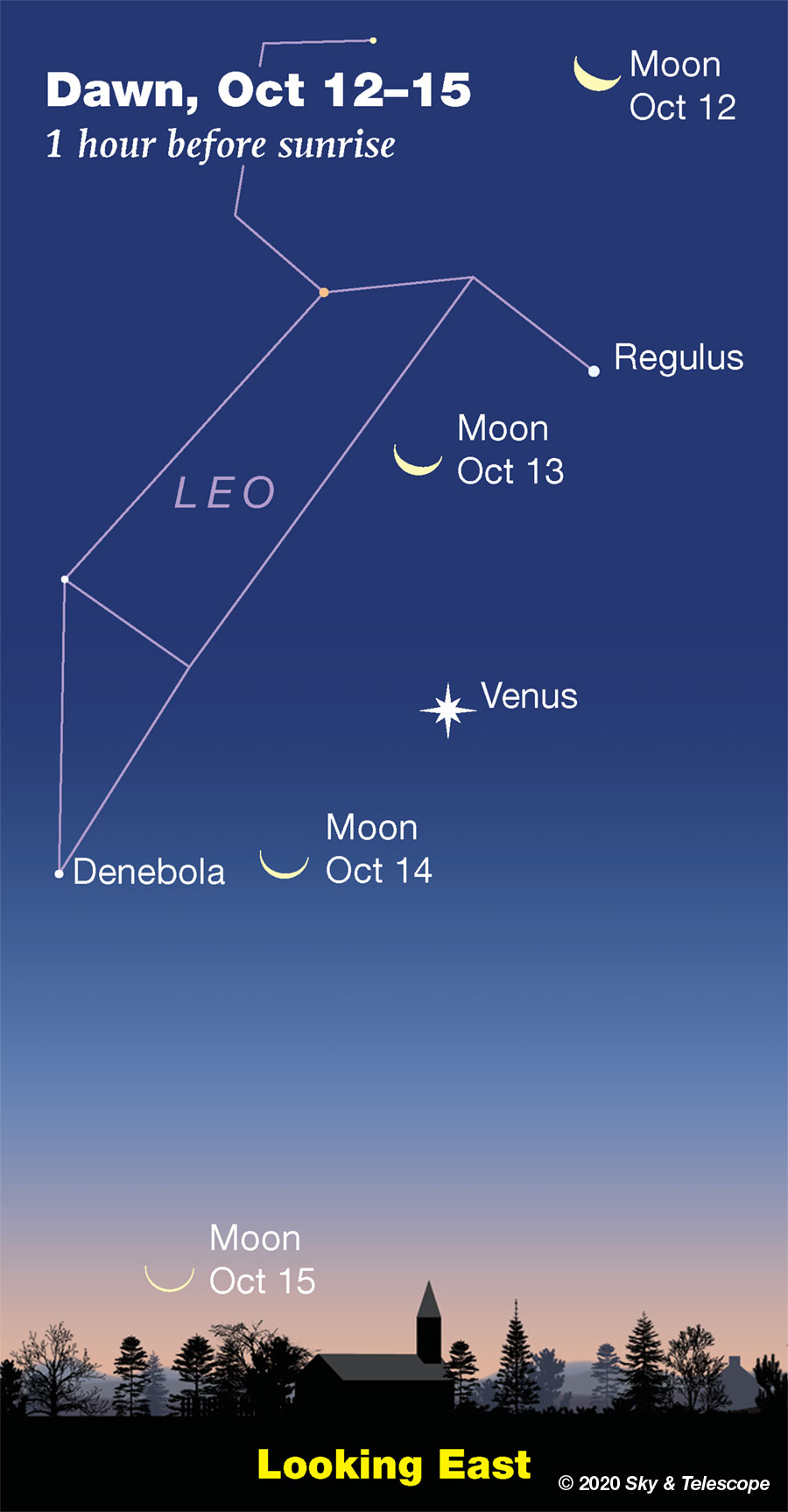
MONDAY, OCTOBER 12
■ In the dawn of Tuesday the 13th, the crescent Moon stands closer over Venus as shown above. Now you'll find Regulus to the Moon's upper right (for North America). Look also for orange Gamma Leonis, only a little fainter than Regulus, to the Moon's upper left. Gamma Leonis is a fine, easy double star for any telescope: magnitudes 2.6 and 3.2, separation 5 arcseconds.
TUESDAY, OCTOBER 13
■ Mars is at opposition, opposite the Sun as seen from Earth. This when it displays its greatest surface brightness in a telescope, because of the opposition effect: a dusty, rubbly surface reflects sunlight a little more efficiently back in the direction it came from. At opposition, Earth lies in that direction. We see also this effect with the rings of Saturn near opposition, and with the full Moon.
■ At dawn on Wednesday the 14th, look for the thin Moon lower left of Venus, as shown above. Look early to catch 2nd-magnitude Denebola, the tail-tip of Leo, to the Moon's left.
WEDNESDAY, OCTOBER 14
■ Now that it's mid-October, Deneb has replaced Vega as the zenith star after nightfall (for skywatchers at mid-northern latitudes).
And so, necessarily, Capricornus has replaced Sagittarius as the zodiacal constellation due south.
THURSDAY, OCTOBER 15
■ Vega is the brightest star very high in the west these evenings. Less high in the southwest is Altair, not quite as bright. Just upper right of Altair, by a finger-width at arm's length, is little orange Tarazed. Down from Tarazed runs the stick-figure backbone of the constellation Aquila, the Eagle. His wingtips are upraised. Altair is his sharp eye.
■ Look to Altair's upper left by a little more than a fist at arm's length, and there's the faint little constellation Delphinus, the Dolphin, leaping in the edge of the Milky Way.
■ Delphinus sports some interesting, little-known telescopic objects — from the Toadstool asterism Thompson 1 near Iota Delphini, to the brightest non-Messier globular cluster in the northern celestial hemisphere (it's 9th magnitude), to the elusive NGC 6928 galaxy cluster (for big scopes; they're magnitude 12.2 and fainter). Explore here using the Deep-Sky Wonders column and charts in the October Sky & Telescope, page 56.
FRIDAY, OCTOBER 16
■ This is the time of year when, after nightfall, W-shaped Cassiopeia stands on end halfway up the northeastern sky — and when, off to its left in the north, the dim Little Dipper extends leftward from Polaris.
■ Jupiter's Great Red Spot should transit Jupiter's central meridian around 9:22 p.m. Eastern Daylight Time.
An hour later, at 10:23 p.m. EDT, Jupiter's moon Io reappears from eclipse out of Jupiter's shadow just east of the planet — very close to Callisto, with Europa and Ganymede farther out. A small telescope will show Io swelling into view over the course of a couple minutes, turning Callisto into an imitation double star.
■ New Moon (exact at 3:31 p.m. EDT).
SATURDAY, OCTOBER 17
■ Cassiopeia stands high in the northeast these evenings, a flattened W standing on end. The third segment of the W, counting down from the top, points almost straight down. Extend that segment twice as far down as its own length, and you're at the Double Cluster in Perseus. This pair of star-swarms is dimly apparent to the unaided eye in a dark sky (use averted vision), and it's visible from almost anywhere with binoculars. It's lovely in telescopes.
This Week's Planet Roundup
Mercury is lost in the glow of sunset.
Venus (magnitude –4.0, in lower Leo) rises in the east in deep darkness more than 1½ hours before dawn begins. By the time dawn gets under way, Venus is well up in fine view as the bright "Morning Star." Regulus, much fainter, is ever farther to its upper right.
In a telescope Venus continues to shrink; it's now only 14 or 15 arcseconds in diameter. And it's growing more gibbous, now about 75% sunlit, as it rounds toward passing behind the Sun next winter.
Mars (magnitude –2.6, in Pisces) comes to opposition on October 13th. All week it is still essentially at its closest to Earth, remaining 22.5 to 22.0 arcseconds in apparent diameter. This is bigger that we will see it again until September 2035.
Mars is climbing into good view a little earlier every night! In late dusk it glares fiery orange, brighter even than Jupiter, low in the east. It's high in the southeast by 10 or 11 p.m. daylight-saving time, and it's its highest at its telescopic best by midnight or 1 a.m., blazing in the south.
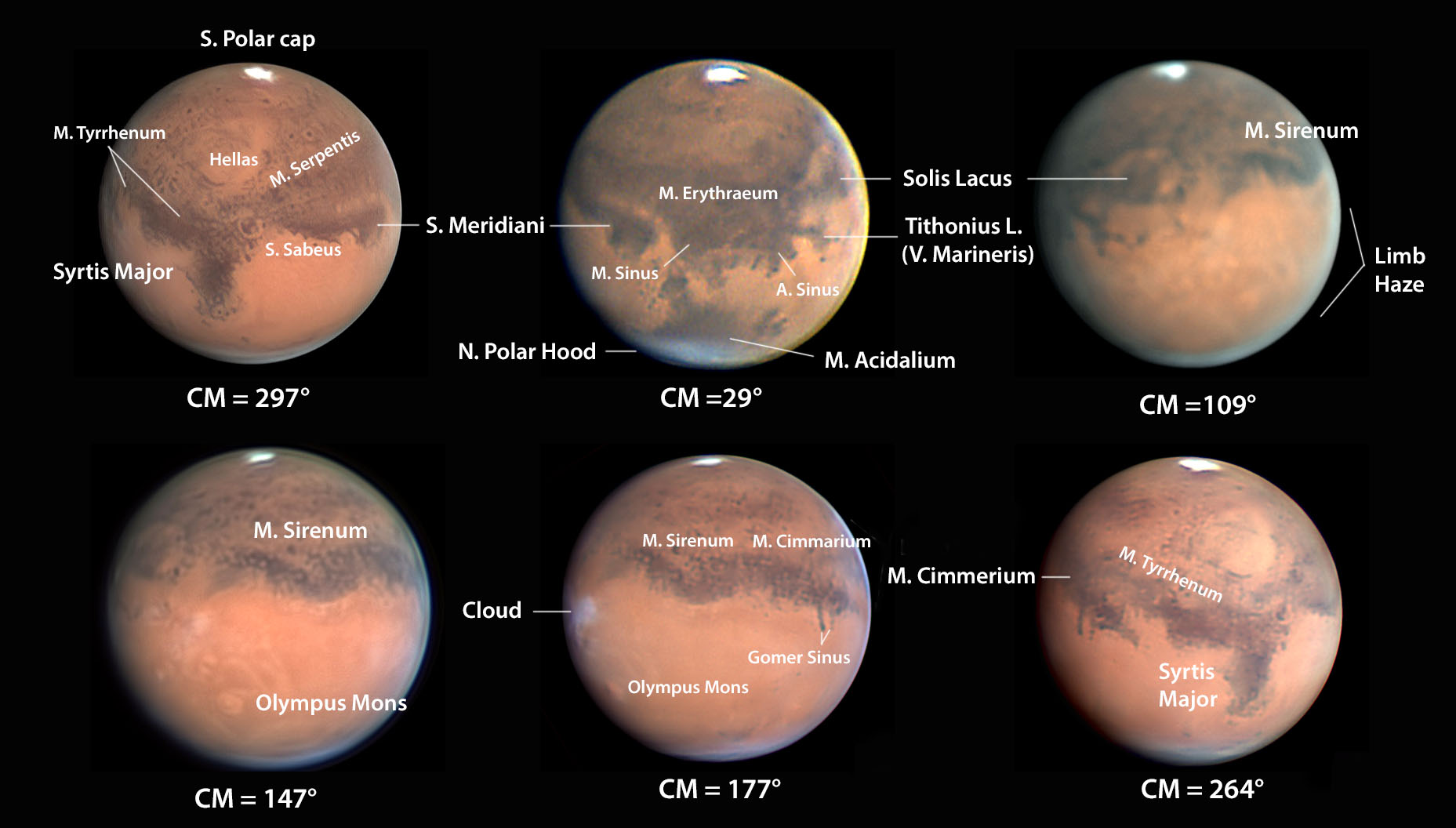
See Bob King's "A Great Year for Mars" in the October Sky & Telescope, page 48, and his Behold Mars! article online. To get a map of the side of Mars facing Earth at the date and time you'll observe, you can use our Mars Profiler. The map there is square; remember to mentally wrap it onto the side of a globe. (Features near the map's edges become very foreshortened; compare with the images above.)
Jupiter and Saturn (magnitudes –2.3 and +0.5, respectively) shine in the south to southwest during dusk and early evening. They tilt more and move to the southwest as evening grows late.
Jupiter is the bright one; Saturn is 7° to its left. Watch the two planets gradually creep toward each other for the rest of the fall. They will pass just 0.1° apart at conjunction on December 21st, low in twilight, just as fall turns to winter.
Telescopically there's a lot happening on Jupiter; see Bob King's Stormy Times on Jupiter. And you can follow the interplay of Jupiter with its moons and their shadows, and find the transit times of Jupiter's Great Red Spot, using the Celestial Calendar section of the current Sky & Telescope.
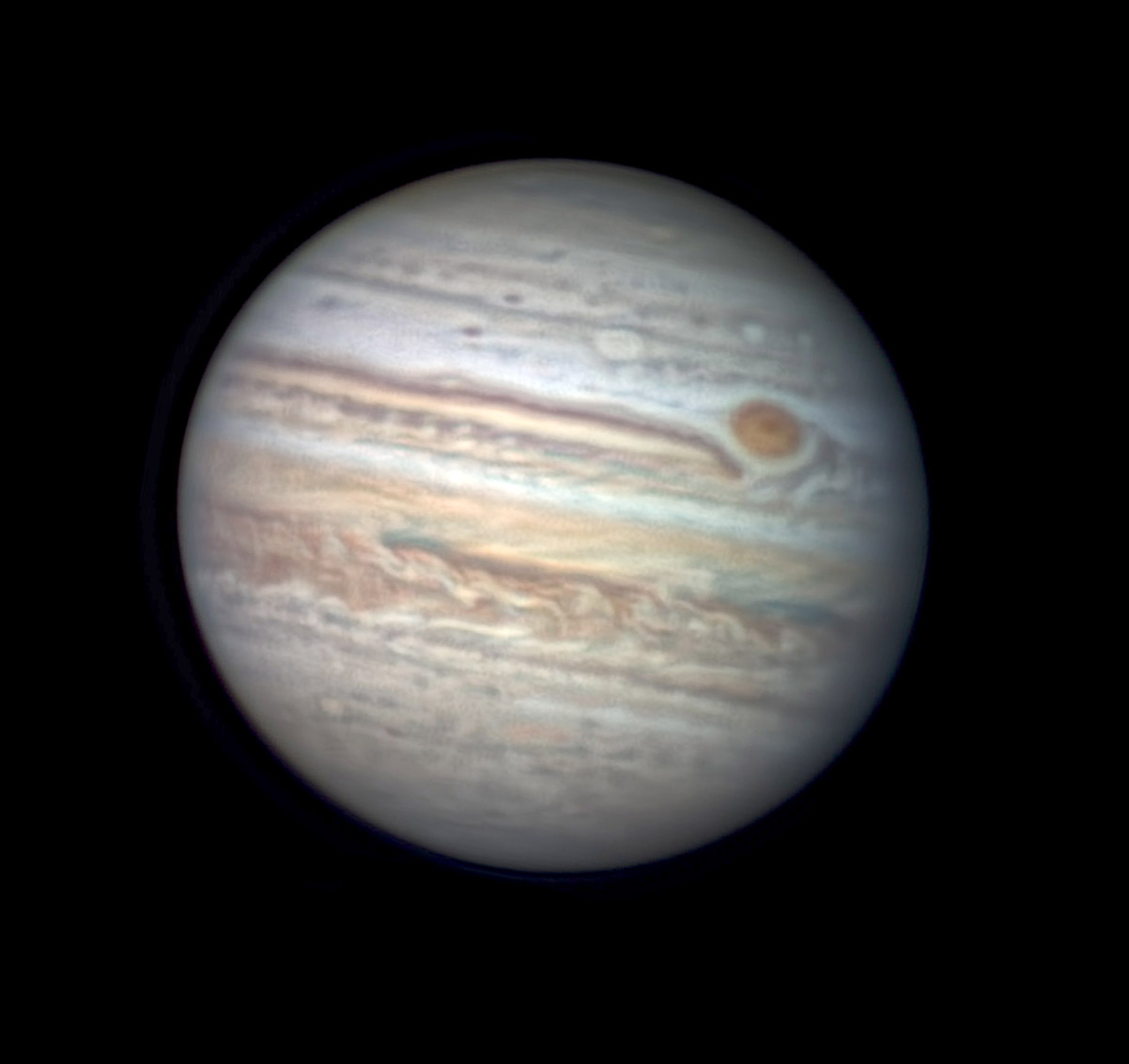
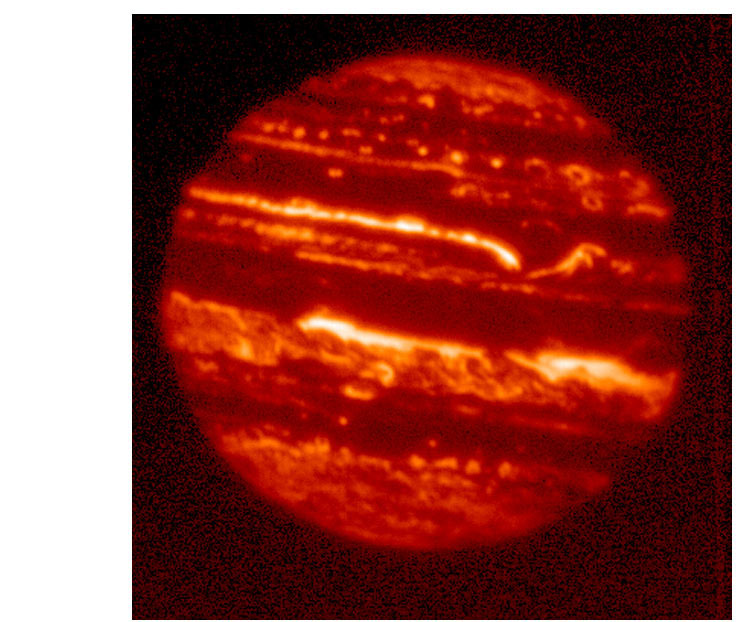
The blue festoon bases, and smaller slightly bluish markings at high latitudes, are areas of clear air that allow a somewhat deeper view. And that's why, at visible wavelengths, they look blue! Clear Jupiter-air preferentially scatters the blue wavelengths in sunlight, just like molecular scattering by clear Earth-air makes our own sky blue.
Uranus (magnitude 5.7, in Aries) is well up in the east by 10 p.m. daylight-saving time, about 18° east of Mars. Uranus is only 3.7 arcseconds wide, but that's enough to appear as a tiny fuzzy ball, not a point, at high power in even a small telescope. Check in on it when you're done with Mars.
Neptune (magnitude 7.8, in Aquarius) is higher in the south-southeast at that time. Neptune is 2.4 arcseconds wide, harder to resolve except in good seeing. Finder charts for Uranus and Neptune.
All descriptions that relate to your horizon — including the words up, down, right, and left — are written for the world's mid-northern latitudes. Descriptions that also depend on longitude (mainly Moon positions) are for North America.
Eastern Daylight Time, EDT, is Universal Time minus 4 hours. (Universal Time is also known as UT, UTC, GMT, or Z time.)
Want to become a better astronomer? Learn your way around the constellations. They're the key to locating everything fainter and deeper to hunt with binoculars or a telescope.
This is an outdoor nature hobby. For an easy-to-use constellation guide covering the whole evening sky, use the big monthly map in the center of each issue of Sky & Telescope, the essential magazine of astronomy.
Once you get a telescope, to put it to good use you'll need a detailed, large-scale sky atlas (set of charts). The basic standard is the Pocket Sky Atlas (in either the original or Jumbo Edition), which shows stars to magnitude 7.6.

Next up is the larger and deeper Sky Atlas 2000.0, plotting stars to magnitude 8.5; nearly three times as many. The next up, once you know your way around, are the even larger Interstellarum atlas (stars to magnitude 9.5) or Uranometria 2000.0 (stars to magnitude 9.75). And be sure to read how to use sky charts with a telescope.
You'll also want a good deep-sky guidebook, such as Sky Atlas 2000.0 Companion by Strong and Sinnott, or the bigger (and illustrated) Night Sky Observer's Guide by Kepple and Sanner.
Can a computerized telescope replace charts? Not for beginners, I don't think, and not on mounts and tripods that are less than top-quality mechanically, meaning heavy and expensive. And as Terence Dickinson and Alan Dyer say in their Backyard Astronomer's Guide, "A full appreciation of the universe cannot come without developing the skills to find things in the sky and understanding how the sky works. This knowledge comes only by spending time under the stars with star maps in hand."
![]() Audio sky tour. Out under the evening sky with your
Audio sky tour. Out under the evening sky with your
earbuds in place, listen to Kelly Beatty's monthly
podcast tour of the heavens above. It's free.
"The dangers of not thinking clearly are much greater now than ever before. It's not that there's something new in our way of thinking, it's that credulous and confused thinking can be much more lethal in ways it was never before."
— Carl Sagan, 1996
"Facts are stubborn things."
— John Adams, 1770
 9
9








Comments
Rod
October 9, 2020 at 8:12 am
mary beth, New Jersey Eclipse Fan. Some great views of Mars last night using my 10-inch telescope. The red filter provided stunning views of dark surface areas and the S&T Mars profiler tool is very good. I also use Starry Night Pro Plus 8 simulation view and mark areas visible for the telescope. A great horn howl was hooting, some bucks were calling, and a skunk came around my area, I could smell skunk very distinctly out there in the fields 🙂
You must be logged in to post a comment.
Alan MacRobertPost Author
October 9, 2020 at 1:28 pm
> smell skunk
Years ago, out in the dark with my 6-inch reflector on a tripod, I would smell skunk often. One night when it was especially strong, my eyepiece view wiggled a little. I though it was our cat rubbing a tripod leg, as usual. I looked down. It was a skunk, with a big white band down its back and a huge black tail... raised. I backed away very carefully, fearing as much for the telescope as for me. He poked around a little longer, took his time, then ambled back into the woods.
You must be logged in to post a comment.
Rod
October 9, 2020 at 1:48 pm
Alan, your report here is great!
You must be logged in to post a comment.
New Jersey Eclipse Fan
October 9, 2020 at 5:17 pm
I've heard skunks make nice pets if they are de-scented (or whatever it's called) and non-rabid. Or is that just a rural legend?
You must be logged in to post a comment.
mary beth
October 10, 2020 at 1:27 am
Hi Rod! You certainly experience all the best of nature. Sounds like a very interesting night! Well we dodged another hurricane, thankfully it did lose strength when it hit the coast. We had some beautiful stratocumulus clouds giving us a purple and orange sky at sunset and then it cleared off enough to see the planets and stars. Three more days till opposition! We have clear skies forecast from this point on through the end of next week... Hope you and New Jersey Eclipse Fan will have great views as well!
You must be logged in to post a comment.
Anthony Barreiro
October 9, 2020 at 7:08 pm
The visible and infrared images of Jupiter and the captions are instructive. They really help me see the clouds in three dimensions. My mnemonic when looking at Jupiter shall be: darker = deeper = warmer; lighter = higher = cooler; blue = clear skies.
You must be logged in to post a comment.
Jim-Gasser
October 11, 2020 at 10:22 pm
I'm confused. I have an astronomy outreach program on Fri Oct 16 and when looking up Jupiter GRS and moon event predictions, I get differing predictions for GRS transit times.
The weekly notes above say for Oct 16 GRS CM transit is 9:22 pm EDT. The S&T Jupiter Moons app says 20:49, 33 minutes earlier. Zooming in on the planet in SkyPortal it appears to be 20:07, over an hour earlier. Zooming in with SkySafari it appears to be about 20:49. I realize there is some variation of the GRS location longitudinally over time, but it seems like a lot. I have observed the GRS and wondered why it seemed not transiting when predicted, but did not investigate.
Can anyone help explain the differences, or which might be the most accurate?
The moon events do not seem to be off, so I must assume GRS prediction is more difficult and variable.
Jim Gasser
You must be logged in to post a comment.
Monica Young
October 12, 2020 at 10:10 am
Dear Jim, The longitude of the Great Red Spot drifts over time, so periodic corrections are needed over time. Unfortunately we are not currently able to update our Jupiter Moons app, so the GRS transit time is off. However, if you use either the time given in the magazine's "Action at Jupiter" section (9:22 p.m. EDT on Oct. 16th) or the online tool: https://skyandtelescope.org/observing/interactive-sky-watching-tools/transit-times-of-jupiters-great-red-spot/ (9:21 p.m. EDT on Oct. 16th), the times given should be accurate to within a few minutes.
You must be logged in to post a comment.
Jim-Gasser
October 13, 2020 at 11:06 pm
Thank you - will do! Just wanted to understand...
You must be logged in to post a comment.
You must be logged in to post a comment.